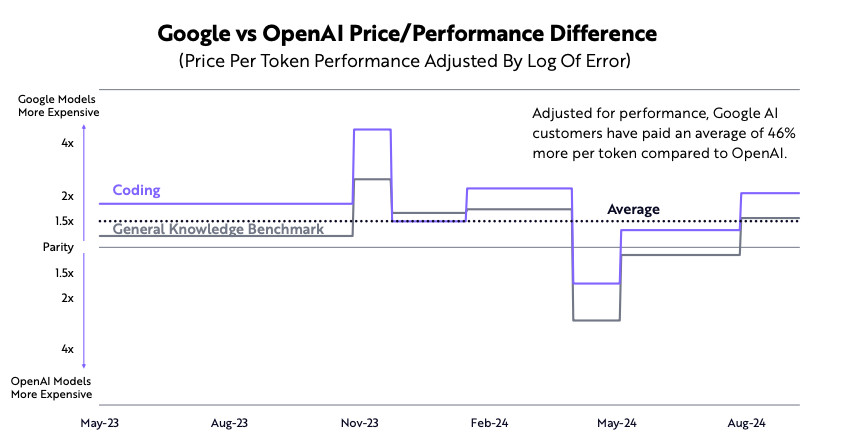Can industry titans like Apple and Google keep up with nimble startups in the race for disruptive technology?

Victoria d’Este
Posted: Oct 4, 2024 1:19 PM Updated: Oct 4, 2024 1:20 PM

Correction and fact check date: October 4, 2024, 1:19 p.m.
briefly
The AI revolution is characterized by unprecedented cost savings, with the performance cost of AI models halving every four months compared to Moore’s Law in semiconductors.

A new white paper released by Cathie Wood’s investment firm, ARK Invest, highlights the complex dynamics as prominent business figures navigate the AI landscape.
Changes in AI Costs
Reducing costs at unparalleled speed is at the core of the AI revolution. Brett Winton, author of the white paper and chief futurist at ARK Invest, highlights that the cost of running a similarly performing AI model is cut in half every four months. This is the largest cost decline curve in technology history, and is expected to continue for the next decade.
To put this in perspective, Winton compares it to Moore’s Law in the semiconductor business, where prices typically fall in half every 18 to 24 months. The results are clear. The pace of the AI revolution is four to six times faster than the pace of the semiconductor revolution, which has been the driving force of technological growth for decades.
Traditional IT companies face a double-edged sword due to this rapid cost decline. On the one hand, it provides an opportunity to take advantage of increasingly powerful AI capabilities while lowering costs. But it can also make it easier for startups and smaller competitors to enter the market and challenge the hegemony of large corporations.
The nature of disruptive technologies
According to ARK Invest, disruptive technology platforms have three key characteristics: They penetrate new or underserved industries, offer significant cost savings, and have business models that take time to generate revenue and may not be financially attractive at first.
These characteristics create an atmosphere in which smaller, more nimble companies can challenge the dominance of industry giants. This is true even if the company in question recognizes the potential of the technology and strives to use it for financial gain.
AI is the most disruptive technology because it has all of these characteristics. Future applications span a wide range of sectors, many of which are currently underserved by current technology, and rapid cost savings are already evident. Moreover, many AI-based business models follow the trend of disruptive technologies by focusing more on user acquisition and data collection rather than quick revenue generation.
Big Tech Approach to AI
Both Apple and Google have taken a cautious approach to AI integration given this disruptive potential. According to Winton, established technology companies often use this strategy to help startups “de-risk” innovative ideas before they become widely available.
This method is represented by how Google handles large language models. Companies waited to release sophisticated language models to the public until OpenAI had been available for more than three years. Nonetheless, Google’s performance was not as good as OpenAI’s, and users had to pay more than 40% more for Google’s most sophisticated model than for OpenAI’s most effective model.

Photo: ARK Invest
Despite its reputation for rigorous product development, Apple has yet to release a major language model. The company will likely launch its first cutting-edge AI-based products in the fall of 2024, much later than many of its competitors.
This systematic approach has its benefits. As Winton points out, transporting goods that exhibit erratic behavior can be somewhat unnerving for those managing a well-established reputation. The foundation of Google and Apple’s success has been providing trustworthy, user-friendly products and services. AI’s ability to produce unexpected or unwanted results poses a serious threat to users’ trust in companies and brands.
Opportunities for New Entrants
Due to the disruptive nature of AI and its rapid price decline, there is a lot of potential for new players to challenge the dominance of entrenched tech giants. Small businesses and startups may be better equipped to take advantage of the full potential of AI because they can move quickly and are less constrained by legacy systems.
This is not just an AI mechanic. Throughout the history of technology, rapid advancements have often come at the expense of incumbents and the emergence of new market leaders. With each transition from mainframe computers to personal computers and mobile devices, a new dominant company emerged.
There may be a similar trend in AI innovation. Companies that can quickly experiment, iterate, and adapt to the changing AI landscape stand to gain a huge advantage. As a result, the tech sector could become more vibrant and competitive, with new companies emerging to challenge established powerhouses like Apple and Google.
Balancing innovation and risk
The challenge for Apple and Google is finding the ideal combination between risk management and innovation. These companies have made billions of users around the world happy by providing sophisticated and reliable products and services. Their cautious approach to AI integration demonstrates a thorough understanding of the potential risks associated with using unexpected technologies at scale.
On the other hand, if you are too careful, you may miss an opportunity. Because AI is developing so rapidly, major changes may occur in the technological environment within a few months. Companies that take a long time to adapt risk having to keep up with evolving markets.
Additionally, due to the nature of AI development, improvements often come through extensive implementation and real-world input. If Apple and Google delay the release of AI-based features and products, our ability to obtain the information and understanding needed to improve and develop AI systems may be reduced.
disclaimer
In accordance with the Trust Project Guidelines, the information provided on these pages is not intended and should not be construed as legal, tax, investment, financial or any other form of advice. It is important to invest only what you can afford to lose and, when in doubt, seek independent financial advice. We recommend that you refer to the Terms of Use and help and support pages provided by the publisher or advertiser for more information. Although MetaversePost is committed to accurate and unbiased reporting, market conditions may change without notice.
About the author
Victoria is a writer covering a variety of technology topics, including Web3.0, AI, and cryptocurrency. Her extensive experience allows her to write insightful articles for a wider audience.
more articles

Victoria d’Este

Victoria is a writer covering a variety of technology topics, including Web3.0, AI, and cryptocurrency. Her extensive experience allows her to write insightful articles for a wider audience.


